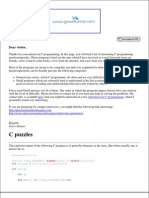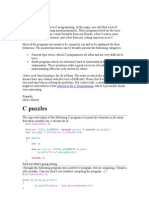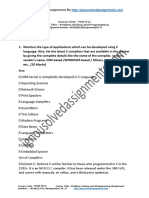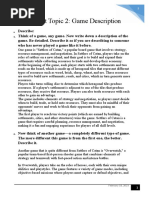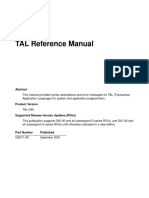Programming and Data Structures: Group I: Sections 1,2,5,6
Programming and Data Structures: Group I: Sections 1,2,5,6
Uploaded by
Rajiv SinghCopyright:
Available Formats
Programming and Data Structures: Group I: Sections 1,2,5,6
Programming and Data Structures: Group I: Sections 1,2,5,6
Uploaded by
Rajiv SinghOriginal Title
Copyright
Available Formats
Share this document
Did you find this document useful?
Is this content inappropriate?
Copyright:
Available Formats
Programming and Data Structures: Group I: Sections 1,2,5,6
Programming and Data Structures: Group I: Sections 1,2,5,6
Uploaded by
Rajiv SinghCopyright:
Available Formats
Programming and Data
Structures
Group I: sections 1,2,5,6
Group I: sections 1,2,5,6
Prof. Rimli Sengupta, CSE
Course Outline (Tentative)
C programming
C programming
Input, output, arithmetic and logical ops
Input, output, arithmetic and logical ops
Control constructs
Control constructs
Functions
Functions
Recursion
Recursion
Dynamic memory allocation
Dynamic memory allocation
File I/o
File I/o
Course Outline (contd.)
Data structures
Data structures
Arrays (1 D, 2 D)
Arrays (1 D, 2 D)
Linked lists
Linked lists
Stack, queue
Stack, queue
Trees, binary search trees
Trees, binary search trees
Algorithms and efficiency analysis
Algorithms and efficiency analysis
Courseware
Textbook: any reputed C language reference
Textbook: any reputed C language reference
Kernighan and Ritchie
Kernighan and Ritchie
The C Programming
The C Programming
Language
Language
Gottfried
Gottfried
Programming with C
Programming with C
Lectures:
Lectures:
will be made available
will be made available
Grading Plan
Theory: 60%
Theory: 60%
Endsem 50%
Endsem 50%
Midsem 30%
Midsem 30%
TA 20%
TA 20%
2 class tests
2 class tests
attendance
attendance
Lab: 40%
Lab: 40%
Questions..questions..
How many have programmed before?
How many have programmed before?
What is programming?
What is programming?
What do you need?
What do you need?
A computer
A computer
Ability to talk to it
Ability to talk to it
High level language (e.g. C)
High level language (e.g. C)
Knowledge of where/how the
Knowledge of where/how the
communication may fail
communication may fail
Programs vs. Programming
Programs:
Programs:
precise recipe for a task
precise recipe for a task
Programming:
Programming:
no
no
recipe
recipe
for good programming
for good programming
but there are guidelines for the result
but there are guidelines for the result
correct
correct
efficient
efficient
upgradeable
upgradeable
style (beautiful code)
style (beautiful code)
science
art
Practice is key
A computer (Level 0 Version)
Central
Processing
Unit (CPU)
Input
Input
Peripherals
Peripherals
Output
Peripherals
Main
Memory
Storage
Peripherals
Memory: Address and Values
CPU: A first cut
PC
IR
MAR
MDR
ALU
R1
R2
R3
R4
FLAGS
Instruction Set
Program
Start
Read M
Write M
Load Data, M
Copy M1, M2
Add M1, M2, M3
Sub M1, M2, M3
Compare M1, M2, M3
Jump L
J_Zero M, L
Halt
0: Start
1: Read 10
2: Read 11
3: Add 10, 11, 12
4: Write 12
5: Halt
High-Level Programs
0: Start
1: Read 20
2: Read 21
3: Compare 20, 21, 22
4: J_Zero 22, 7
5: Write 20
6: Jump 8
7: Write 21
8: Halt
Variables x, y;
Begin
Read (x);
Read (y);
If (x >y) then Write (x)
else Write (y);
End.
Examples of Software
Read an integer and
Read an integer and
determine if it is a prime
determine if it is a prime
number.
number.
A Palindrome recognizer
A Palindrome recognizer
Read in airline route
Read in airline route
information as a matrix and
information as a matrix and
determine the shortest time
determine the shortest time
journey between two airports
journey between two airports
Telephone pole placement
Telephone pole placement
problem
problem
Patriot Missile Control
Patriot Missile Control
A Word
A Word
-
-
processor
processor
A C language Compiler
A C language Compiler
Windows 2000 operating
Windows 2000 operating
system
system
Finger
Finger
-
-
print recognition
print recognition
Chess Player
Chess Player
Speech Recognition
Speech Recognition
Language Recognition
Language Recognition
Discovering New Laws in
Discovering New Laws in
Mathematics
Mathematics
Automatic drug discovery
Automatic drug discovery
First C program - 1
#include <
#include <
stdio
stdio
.h>
.h>
main ()
main ()
{
{
printf
printf
("Hello, World!
("Hello, World!
\
\
n") ;
n") ;
}
}
First C program - 2
#include <
#include <
stdio
stdio
.h>
.h>
main ()
main ()
{
{
printf
printf
("Hello, World! ") ;
("Hello, World! ") ;
printf
printf
("Hello
("Hello
\
\
n World!
n World!
\
\
n") ;
n") ;
}
}
First C program - 3
#include <
#include <
stdio
stdio
.h>
.h>
main ()
main ()
{
{
printf
printf
("Hello, World!
("Hello, World!
\
\
n") ;
n") ;
printf
printf
("Hello
("Hello
\
\
n World!
n World!
\
\
n") ;
n") ;
printf
printf
("Hell
("Hell
\
\
no
no
\
\
t World!
t World!
\
\
n") ;
n") ;
}
}
First Program: Reading
#include <
#include <
stdio
stdio
.h>
.h>
main ()
main ()
{
{
int
int
num;
num;
scanf
scanf
("%d", &num) ;
("%d", &num) ;
printf
printf
("%d
("%d
\
\
n", num) ;
n", num) ;
}
}
Second C program - 1
#include <
#include <
stdio
stdio
.h>
.h>
main ()
main ()
{
{
int
int
x;
x;
int
int
y;
y;
x=1;
x=1;
y=3;
y=3;
printf
printf
("x = %d, y= %d
("x = %d, y= %d
\
\
n", x, y);
n", x, y);
}
}
Variables in Memory
Memory location allocated
to a variable X
Instruction executed
X = 10
T
i
m
e
10 X = 20
X = X +1
X = X*5
Variables in Memory
Memory location allocated
to a variable X Instruction executed
X = 10
T
i
m
e
20
X = 20
X = X +1
X = X*5
Variables in Memory
Memory location allocated
to a variable X Instruction executed
X = 10
T
i
m
e
21 X = 20
X = X +1
X = X*5
Variables in Memory
Memory location allocated
to a variable X Instruction executed
X = 10
T
i
m
e
105
X = 20
X = X +1
X = X*5
Variables (contd.)
20
?
X = 20
X
Y=15
X = Y+3
Y
Y=x/6
Variables (contd.)
20
15
X = 20
X
Y=15
X = Y+3
Y
Y=x/6
Variables (contd.)
18
15
X = 20
X
Y=15
X = Y+3
Y
Y=x/6
Variables (contd.)
18
3
X = 20
X
Y=15
X = Y+3
Y
Y=X/6
Second C program - 2
#include <
#include <
stdio
stdio
.h>
.h>
main()
main()
{
{
int
int
x, y, sum;
x, y, sum;
scanf
scanf
(%d%d,&x,&y);
(%d%d,&x,&y);
sum = x + y;
sum = x + y;
printf
printf
( %d plus %d is %d
( %d plus %d is %d
\
\
n, x, y, sum );
n, x, y, sum );
}
}
Second C program - 3
#include <
#include <
stdio
stdio
.h>
.h>
main()
main()
{
{
float x, y;
float x, y;
scanf
scanf
(%f%f,&x,&y);
(%f%f,&x,&y);
printf
printf
( %f plus %f is %f
( %f plus %f is %f
\
\
n, x, y, x+y);
n, x, y, x+y);
}
}
Third C program
#include <
#include <
stdio
stdio
.h>
.h>
main()
main()
{
{
float cent,
float cent,
fahr
fahr
;
;
scanf
scanf
(%f,¢);
(%f,¢);
fahr
fahr
=
=
printf
printf
( %f C equals %f F
( %f C equals %f F
\
\
n, cent,
n, cent,
fahr
fahr
);
);
}
}
Centigrade to Fahrenheit
#include <
#include <
stdio
stdio
.h>
.h>
main()
main()
{
{
float cent,
float cent,
fahr
fahr
;
;
scanf
scanf
(%f,¢);
(%f,¢);
fahr
fahr
= cent*(9.0/5.0) + 32;
= cent*(9.0/5.0) + 32;
printf
printf
( %f C equals %f F
( %f C equals %f F
\
\
n, cent,
n, cent,
fahr
fahr
);
);
}
}
This does not work!
#include <
#include <
stdio
stdio
.h>
.h>
main()
main()
{
{
float cent,
float cent,
fahr
fahr
;
;
scanf
scanf
(%f,¢);
(%f,¢);
fahr
fahr
= cent*(9/5) + 32;
= cent*(9/5) + 32;
printf
printf
( %f C equals %f F
( %f C equals %f F
\
\
n, cent,
n, cent,
fahr
fahr
);
);
}
}
More on expressions
#include <
#include <
stdio
stdio
.h>
.h>
main()
main()
{
{
float cent,
float cent,
fahr
fahr
;
;
scanf
scanf
(%f,¢);
(%f,¢);
fahr
fahr
= cent*9/5 + 32;
= cent*9/5 + 32;
printf
printf
( %f C equals %f F
( %f C equals %f F
\
\
n, cent,
n, cent,
fahr
fahr
);
);
}
}
Largest of two numbers
#include <
#include <
stdio
stdio
.h>
.h>
main()
main()
{
{
int
int
x, y;
x, y;
scanf
scanf
(%d%d,&x,&y);
(%d%d,&x,&y);
if (x>y)
if (x>y)
printf
printf
(Largest is %d
(Largest is %d
\
\
n,x);
n,x);
else
else
printf
printf
(Largest is %d
(Largest is %d
\
\
n,y);
n,y);
}
}
What does this do?
#include <
#include <
stdio
stdio
.h>
.h>
main()
main()
{
{
int
int
x, y;
x, y;
scanf
scanf
(%d%d,&x,&y);
(%d%d,&x,&y);
if (x>y)
if (x>y)
printf
printf
(Largest is %d
(Largest is %d
\
\
n,x);
n,x);
printf
printf
(Largest is %d
(Largest is %d
\
\
n,y);
n,y);
}
}
You might also like
- ACFrOgA6czRCtUKewY5v 4 3iaryvn018 83qoC9kQ-AZEnOtn8lRl8A9h2 p9UqYLled9C25uspRI8LRXhkpaifxNYNtntGN1 EKQeDuiM3-N3V1W11dYRSR9eBVnvoMdmk6gXLWkBKBn JJZXDDocument38 pagesACFrOgA6czRCtUKewY5v 4 3iaryvn018 83qoC9kQ-AZEnOtn8lRl8A9h2 p9UqYLled9C25uspRI8LRXhkpaifxNYNtntGN1 EKQeDuiM3-N3V1W11dYRSR9eBVnvoMdmk6gXLWkBKBn JJZXDhimanshuomar007No ratings yet
- Lab 6 ReportDocument45 pagesLab 6 ReportNIKESH RANABHATNo ratings yet
- Au Ppsc Lab Record 06-12-24Document112 pagesAu Ppsc Lab Record 06-12-24anunayxNo ratings yet
- Computer Programming Lab Programs 1 To 38Document22 pagesComputer Programming Lab Programs 1 To 38yharsha782No ratings yet
- Assignment # 1 Computer Programming (Lab)Document28 pagesAssignment # 1 Computer Programming (Lab)Muhammad ZaynNo ratings yet
- C PROGRAMMES - SET-1 - GECR GEEK - UpdatedDocument8 pagesC PROGRAMMES - SET-1 - GECR GEEK - Updatedyash gamingNo ratings yet
- CP Manual 1Document140 pagesCP Manual 1satyam sharmaNo ratings yet
- C Puzzles: Dear VisitorDocument19 pagesC Puzzles: Dear VisitorZishan CseNo ratings yet
- AI and DAA Practical RecordDocument40 pagesAI and DAA Practical RecordprasadNo ratings yet
- C Language Lab ManualDocument35 pagesC Language Lab ManualSiddhartha KancharlaNo ratings yet
- C ProgrammingDocument186 pagesC ProgrammingSourish SarkarNo ratings yet
- C PUZZLES, Some Interesting C ProblemsDocument17 pagesC PUZZLES, Some Interesting C ProblemsAjay MehraNo ratings yet
- Computer Programming LabDocument72 pagesComputer Programming Labbiswadeepbasak0212No ratings yet
- C LanguageDocument71 pagesC LanguageZaiba KhanNo ratings yet
- CDocument31 pagesCratulray2006100% (3)
- Basics of Computer FileDocument18 pagesBasics of Computer FilerahulNo ratings yet
- PART A 1-7 Lab ManualDocument10 pagesPART A 1-7 Lab Manualchandu7130No ratings yet
- Lab 2Document3 pagesLab 2venkateshNo ratings yet
- Final ProjectDocument26 pagesFinal ProjectShwetabh SumanNo ratings yet
- CP Manual PDFDocument79 pagesCP Manual PDFsatyam sharmaNo ratings yet
- Unit 3 Input Output StatementsDocument8 pagesUnit 3 Input Output StatementsShiva ShresthaNo ratings yet
- Fundamental of Computer Programming in C 08082016Document29 pagesFundamental of Computer Programming in C 08082016Faiz Ahmed khanNo ratings yet
- Homework Sets MergedDocument45 pagesHomework Sets MergedPriyankaNo ratings yet
- C Program Practical FileDocument36 pagesC Program Practical FileSukhchain Singh100% (2)
- C Prog R19 Lab ManualDocument48 pagesC Prog R19 Lab Manualudayalugolu6363No ratings yet
- CS Iyr P II Practical 2019Document20 pagesCS Iyr P II Practical 2019CGA 21-22No ratings yet
- Rdinaz PDFDocument18 pagesRdinaz PDFvaishnaviNo ratings yet
- C Lab MaterialDocument16 pagesC Lab Material080bct082.shrutiNo ratings yet
- Lab Report On C Programming For Grade 12 1Document41 pagesLab Report On C Programming For Grade 12 1Uk KingNo ratings yet
- C Lab Worksheet 5 - 2 C/C++ Variable, Operator and Type 3: // Needed For PrintfDocument7 pagesC Lab Worksheet 5 - 2 C/C++ Variable, Operator and Type 3: // Needed For Printfsalma_1No ratings yet
- C PuzzlesDocument12 pagesC PuzzlesShreeji ShethNo ratings yet
- NikhilDocument28 pagesNikhiljagdeep67676No ratings yet
- Digital Assignment-6: Name: Bejugam Shiva Suprith REG NO: 18BCE0427 Faculty: Narayanamoorthi M SLOT: L59+L60Document14 pagesDigital Assignment-6: Name: Bejugam Shiva Suprith REG NO: 18BCE0427 Faculty: Narayanamoorthi M SLOT: L59+L60shivaNo ratings yet
- Assignment# 3: Some Programming ExamplesDocument6 pagesAssignment# 3: Some Programming ExamplesSaad Javaid SiddiqueNo ratings yet
- Programming AssignmentDocument27 pagesProgramming Assignments.mohaiminmahinNo ratings yet
- 309-PCD REC - RemovedDocument46 pages309-PCD REC - RemovedDarshu deepaNo ratings yet
- TipsterDocument142 pagesTipsterbanu pradeepNo ratings yet
- System Software and Operating System Lab ManualDocument36 pagesSystem Software and Operating System Lab ManualPradyot SNNo ratings yet
- HTTP WWW Gowrikumar Com CDocument17 pagesHTTP WWW Gowrikumar Com Cnehakhandu7885No ratings yet
- 2 SequenceDocument14 pages2 SequencelaltejaNo ratings yet
- C Programs For Turbo C - 240516 - 093056Document25 pagesC Programs For Turbo C - 240516 - 093056rafathfirdous217No ratings yet
- Lab Manual PPSCDocument35 pagesLab Manual PPSCuday1.indiaNo ratings yet
- Au Ppsc Lab Record 09-12-24Document112 pagesAu Ppsc Lab Record 09-12-24anunayxNo ratings yet
- Practical Programs 1. Write A Program To Find The Largest of Three Numbers Using If and Conditional OperatorDocument16 pagesPractical Programs 1. Write A Program To Find The Largest of Three Numbers Using If and Conditional OperatorComputer DepartmentNo ratings yet
- Practical File 1 To 41 PDFDocument91 pagesPractical File 1 To 41 PDFTIRTH JOSHI100% (1)
- Documentation For This Question. Assumptions Can Be Made Wherever NecessaryDocument9 pagesDocumentation For This Question. Assumptions Can Be Made Wherever NecessaryShikha AgarwalNo ratings yet
- Lab Manual Computer Science For FDP in Physics: #Include #IncludeDocument15 pagesLab Manual Computer Science For FDP in Physics: #Include #IncludeSanthosh GNo ratings yet
- C Program AssignmentDocument20 pagesC Program AssignmentsachinNo ratings yet
- Compiler Design ProgramsDocument59 pagesCompiler Design ProgramsrajNo ratings yet
- B.SC (It) 6Th Sem Practical Question Paper With ANSWER... : 1. Write A Program For Frame Sorting Technique Used in BuffersDocument13 pagesB.SC (It) 6Th Sem Practical Question Paper With ANSWER... : 1. Write A Program For Frame Sorting Technique Used in BuffersChitrangada ChakrabortyNo ratings yet
- Lab ManualDocument32 pagesLab ManualChinmayee BhatNo ratings yet
- C & Matlab Lab Manual Format PDFDocument40 pagesC & Matlab Lab Manual Format PDFGayam Nagarjuna ReddyNo ratings yet
- MCS-011 Problem Solving and Programming AssignmentDocument8 pagesMCS-011 Problem Solving and Programming AssignmentSumit RanjanNo ratings yet
- AssignmentDocument1 pageAssignmentMOhammad Waqas ShoukatNo ratings yet
- Agni College of Technology Mock Test - 2: Find The Output: (Questions 1 To 10)Document5 pagesAgni College of Technology Mock Test - 2: Find The Output: (Questions 1 To 10)Madan BalaNo ratings yet
- CPF L;AB MANNUALDocument19 pagesCPF L;AB MANNUALghanshyamp873No ratings yet
- Worksheet For CS3Document5 pagesWorksheet For CS3Shubham JadhavNo ratings yet
- Os ContinueDocument20 pagesOs Continueanshikarajput336No ratings yet
- Ex. 1Document12 pagesEx. 1ravinethra27No ratings yet
- 209Document4 pages209Nezer VergaraNo ratings yet
- CDC MegaDocument2 pagesCDC MegaHuynh ECyberNo ratings yet
- November 2003 Paper 2Document4 pagesNovember 2003 Paper 2api-3753397No ratings yet
- Exercises Basic Syntax PDFDocument1 pageExercises Basic Syntax PDFamitsinghNo ratings yet
- Project Topic 2Document6 pagesProject Topic 2aditiNo ratings yet
- Design and DevelopmentDocument9 pagesDesign and DevelopmentTej SihoraNo ratings yet
- Software Testing BooksDocument13 pagesSoftware Testing BooksNenad PetrövicNo ratings yet
- AVFM-II Manual Series A.10 SpanishDocument47 pagesAVFM-II Manual Series A.10 SpanishVíctor Hugo Concha OrmeñoNo ratings yet
- Kolida SDE 28S Echo Sounder User Manual 20200806Document80 pagesKolida SDE 28S Echo Sounder User Manual 20200806sklshakil8298No ratings yet
- Benning CatalogDocument20 pagesBenning CatalogNebun de LegatNo ratings yet
- SD2201-Ch2-Konsep FungsiDocument31 pagesSD2201-Ch2-Konsep FungsiHusni Na'fa MubarokNo ratings yet
- Hadoop EcosystemDocument4 pagesHadoop Ecosystemshweta shedshaleNo ratings yet
- Biostar: H110MH PRO D4 MotherboardDocument6 pagesBiostar: H110MH PRO D4 MotherboardPrivate music hackerNo ratings yet
- Absolute PDF ServerDocument2 pagesAbsolute PDF Serverdiggeridoo100No ratings yet
- c6100 Color PressDocument16 pagesc6100 Color PressChenna VijayNo ratings yet
- inkNote_Color_User_ManualDocument75 pagesinkNote_Color_User_ManualJoshua C.No ratings yet
- Witcher - Wild Hunt WorkoutDocument4 pagesWitcher - Wild Hunt WorkoutMEIBNo ratings yet
- Plxbroch 1222184272Document5 pagesPlxbroch 1222184272Adam MaherNo ratings yet
- 23rd Dec SliptestDocument1 page23rd Dec Sliptestnaveen studentNo ratings yet
- Preboard - 1 2023 NovDocument9 pagesPreboard - 1 2023 Novlaxmi567No ratings yet
- Lab 5.5.1: Examining A Device's Gateway: Topology DiagramDocument8 pagesLab 5.5.1: Examining A Device's Gateway: Topology DiagramMichael John SantosNo ratings yet
- Quanteda PDFDocument2 pagesQuanteda PDFayrusuryaNo ratings yet
- 4-Bit CSA/CLA Block Diagram 4-Bit CSA/CLA VHDL Code: S X + Y + Z + WDocument4 pages4-Bit CSA/CLA Block Diagram 4-Bit CSA/CLA VHDL Code: S X + Y + Z + WMaitri SenNo ratings yet
- SDLC Models: Linear ApproachDocument10 pagesSDLC Models: Linear ApproachvsrajeshvsNo ratings yet
- Level 2 Blockchain Networks and Extended ConsensusDocument4 pagesLevel 2 Blockchain Networks and Extended Consensusyathurshan245No ratings yet
- Veeam ONE 9 5 U3 Alarms GuideDocument158 pagesVeeam ONE 9 5 U3 Alarms GuidezsmoNo ratings yet
- WebLogs Core Diagnostics-LogsDocument61 pagesWebLogs Core Diagnostics-Logsiyatmaryati78No ratings yet
- Tal Reference ManualDocument638 pagesTal Reference ManualAlvaro Pereira PachecoNo ratings yet
- Librarian Kvs SyllabusDocument7 pagesLibrarian Kvs SyllabusmadhusharmasnsNo ratings yet
- Shamikh Bhatti: Address: Phone: Email: ObjectiveDocument2 pagesShamikh Bhatti: Address: Phone: Email: ObjectiveWarda BhattiNo ratings yet







